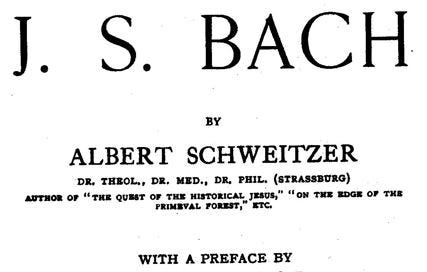Albert Schweitzer (1875-1965) and the renaissance of the organ music of J.S.Bach
When I was at school Albert Schweitzer was widely recognized and respected for his establishment in 1913 of a hospital at Laberéné in what is now Gabon. It was only many years later that I discovered that Schweitzer was an excellent organist after hearing on the radio excerpts from some of the recordings he made (many in London) in 1935-1936. Then a decade ago I began to appreciate fully the role that Schweitzer had played in bringing the organ music of Bach out of the silence that had enshrouded it since the death of the composer in 1750.
This appreciation grew on reading the 590pp biography of Charles-Marie Widor by John Near (published in 2012) and the chance discovery in a secondhand bookshop in Lewes of the two-volume biography of Bach that Schweitzer had written in French in 1905 and which then revised and published in English in 1923.
By 1893 Schweitzer was already an accomplished organist but decided to go to Paris for some lessons from Widor. Widor may well have improved Widor’s technique but of more importance was that Schweitzer explained to Widor how Bach had interpreted the text of the Lutheran chorales. Widor was at a loss to understand the intent behind the harmonic structure and chromatic shifts in Bach’s treatment of the chorales. It is of note that the title in French of Schweitzer’s book was J.S.Bach: Le musicien-poète.a subtlety lost in the more prosaic title (see above) of the subsequent English translation!
In 1910 the music publisher G.Schirmer asked Widor to prepare a complete edition of the organ music of Bach. Widor agreed if he could work with Schweitzer as the co-author. Five volumes were published in 1912-1913 but a combination of events (WW1 and Schweitzer’s move to Gabon) brought a halt to the project and the editing of the chorale preludes (ironically!) was never completed. Of course, research into Bach’s life and work over the last century means that these volumes are of largely historic interest. Their importance is that Widor and Schweitzer wished to publish an edition of Bach’s music without ill-founded 19th Century comments on speeds, registration and phrasing, amongst many other issues. As a result, the Widor/Schweitzer editions provided the groundwork for others (notably Marcel Dupré) to prepare their own editions.
Schweitzer came to realise that interpreting Bach on the organ in a way that was faithful to Bach’s intentions was not possible on organs designed in the latter half of the 19th century. In 1906 he published "The Art of Organ Building and Organ Playing in Germany and France". An expanded and revised edition was published in 1927 and became the creed of what was termed the Orgelbewegung the objective of which was to build organs along baroque perspectives. The texts of both the 1906 and 1927 essays were published by the Organ Historical Society in 1992.
My current interest in Schweitzer are his comments about the Trio Sonatas that I am starting to re-learn.
“Whoever has studied them thoroughly will find scarcely a single difficulty in the old or even modern organ music that her has not met with there and learned how to overcome; and before all he will have attained that absolute precision that is the chief essential for good organ-playing, since in this complicated trio-playing the slightest unevenness in touch is heard with appalling clearness”.
Absolutely!




